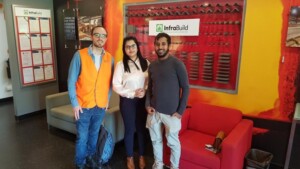Michelle Dunn and Jagannatha Charjee Pyaraka represented the Australian Cobotics Centre alongside Weld Australia at the ‘Australian Manufacturing Week’ earlier this month, showcasing their new cobot.

Michelle Dunn and Jagannatha Charjee Pyaraka represented the Australian Cobotics Centre alongside Weld Australia at the ‘Australian Manufacturing Week’ earlier this month, showcasing their new cobot.

Welcome to Yuan Liu, our newest PhD Researcher working on the Augmented and Virtual Reality in Collaborative Robotics project, as part of the Designing Socio-technical Robotic Systems program supervised by Glenda Caldwell.
Yuan’s research will investigate co-design and development of immersive visualisation (i.e. augmented reality, virtual reality) approaches to simulate, prototype, and evaluate products and spaces for human-robot collaboration within real-world manufacturing processes and contexts. The benefits of using immersive visualisation approaches will include the ability to evaluate before, during, and after different collaborative robotic settings and necessary manufacturing process and spatial adaptations have been made.
Yuan’s current research interests will focus on multimedia technologies (Virtual Reality and Augmented Reality) and human computer interaction.
Welcome Yuan!
Read more about the program.
Welcome to Louis Fernandez! Louis is a PhD Researcher working on our Multi-modal Human Robot Collaboration project, which is part of the Human Robot Interaction program. He is based at UTS and supervised by Marc Carmichael.
Louis’s research will develop a vocabulary of multimodal HRC interaction techniques to accomplish tasks such as specifying the intended path for the robotic tool to follow by manually drawing onto the work surface, instructing the robot through naturalistic speech and gesture, and directly sensing feedback on the state of a robotic task through visual, auditory, and haptic feedback.
The project will also study the needs for human robot interaction in an authentic work context to make sure that the interaction techniques are appropriate for use in that setting.
Welcome Louis!
Read more about the program.

The Australian Cobotics Centre has some incredibly E.P.I.C. researchers. Each month we will be profiling a different researcher.
Fred (Fouad) Sukkar is a robotics researcher with several years of experience in the areas of agricultural robotics and industrial automation. Fred has been working on developing algorithms to enable natural and safe human-robot collaborative environments and is based at UTS.
We interviewed Fred recently to find out more about why he does what he does.
I am the postdoctoral research fellow for the Biomimic Cobots program which aims to enable robot-human collaborative work environments. My work helps to make cobots (collaborative robots) more intelligent through bioinspiration in order to carry out practical and valuable work in the real world. Recently, as part of my work with program 1 we developed a first proof of concept robot design for identifying and removing short bars from a conveyor line for our industry partner Infrabuild. The design of the system was inspired by the way workers currently carry out this task. The broader aim of my work is to enable robots that behave naturally when performing tasks with and around humans and to make their jobs safer. This is an important step for robots to become widely adopted and embraced by the manufacturing industry.
The ACC was a great opportunity to pursue my research interests alongside other prominent academics in the field. It was also an exciting opportunity to be a part of a first-of-its-kind effort to put Australia on the map for excellence and innovative research in manufacturing. The work with the centre extends my PHD research which was on robotic manipulator planning and perception. In particular, I developed principled algorithms to increase reliability and efficiency while having some practical guarantees about the robot’s behaviour. Also, this role will be an opportunity to translate my research to industry and also explore some of my future research such as leveraging robotic learning methods to improve performance and solve a wider range of problems.
The work I did during my PhD on multi-robot active perception was a culmination of ideas to different problems I had been thinking about and working on for a long time while being in both academia and industry. It was the first real hardware demonstration of a system of its scale and complexity running in real time. The resulting paper titled “Multi-Robot Region-of-Interest Reconstruction with Dec-MCTS” won a best paper award at ICRA, the largest international robotics conference. The fundamental ideas behind this work are currently being used in the research I am working on with ACC.
My hope is that my work with the ACC will lead to truly human-robot collaborative work environments where robots improve the quality of life of workers, whether it be a safer workplace or empowering them to carry out tasks that they would not have been able to do otherwise. I also aim to establish myself as a leading researcher in the field with the help of my excellent collaborators in the Centre.
Apart from robotics, music is a huge passion of mine and I could easily give a presentation on one or many of my favourite bands such as Radiohead, Nirvana, Pink Floyd, Led Zeppelin, The Mars Volta, Muse or Silverchair (just to name a few).
Thanks to Research program co-Lead, Matthias Guertler, PhD researchers, Munia Ahamed, and Fikre Hagos and visiting Masters researcher from Nuremberg University of Applied Sciences, Philipp Bauer, who represented the Centre at ‘Building a Pipeline of Engineers: UTS Connections’ on Wednesday.
The event, co-hosted by the University of Technology Sydney and Engineers Australia was an opportunity for businesses in the NSW region to hear about:
– projects that UTS students have been involved in,
– the benefits of hosting students as interns including the creation of a pipeline of talent for your organisation
– current students who are seeking internships and other opportunities.
If you are interested in exploring a partnership with the Australian Cobotics Centre please get in contact. We are looking for industry partners in NSW and would love to introduce you to our PhD researchers and their projects.
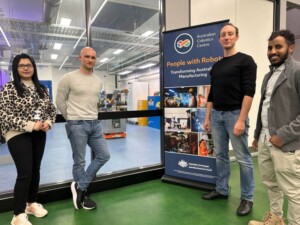
Australian Cobotics Centre partner ARM Hub (Advanced Robotics for Manufacturing) hosted Federal Minister for Industry and Science Ed Husic MP and Federal Minister for Aged Care and Minister for Sport Anika Wells today at their Northgate facility.
ACC PhD student Barış Balcı demonstrated his autonomous sanding research and ACC Director Jonathan Roberts showed the Centre’s work with ACC partner InfraBuild (whose Rooty Hill Steel Mill is in Ed Husic’s electorate). Other ACC people in attendance were Professor Roy Green (Member of the Centre Advisory Board), Associate Prof Cori Stewart (Centre CI and CEO of ARM Hub), Prof Will Browne (Centre CI) and Müge Belek Fialho Teixeira (Centre CI).
Thanks so much to ARM Hub for hosting this great event.
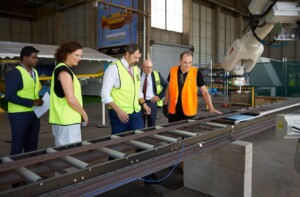
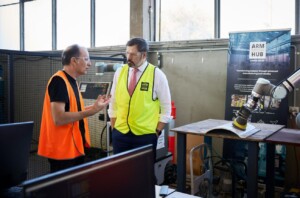

Congratulations to Dr Matthias Guertler and team (including Dr. Nathalie Sick, Gavin Paul, Marc Carmichael, Manisha Amin, Rebecca Grace, Sazzad Hussain, Laura Tomidei, Annika Wambsganss, Victor Hernandez Moreno, and Leila Frijat) on their Cobots Work Health & Safety project completed in partnership with the NSW Centre for Work Health and Safety and funded through the NSW Workers Compensation Operational Fund.
The team have developed guidelines, methods and principles to design safe cobots and cobot workplaces. These are fantastic resources for organisation who are planning on implementing collaborative robots (“cobots”) or are curious of how to work safely with cobots in general?
The project team have created a website full of useful resources that include:
– An introduction to, and general safety information, aspects of human-cobot collaboration.
– Guidance documents to assist in the planning of an upcoming or amended workplace.
– Checklists and assessments to assess an existing or future workplace’s safety features
Read more HERE
Postdoctoral Research Fellow, Dr Stine Johansen was at the IEEE Human Robot Interaction Conference this week where she presented her paper, Illustrating Robot Motions.
Stine created a video presentation of the paper which gives an overview of the survey and examples of findings relating to how robot movements are illustrated in the ACM/IEEE Conference on Human-Robot Interaction proceedings from 2016 to 2022.
Download the paper and Stine’s video here: Illustrating Robot Movements | Proceedings of the 2023 ACM/IEEE International Conference on Human-Robot Interaction
We congratulate Stine, Jared and Markus on their paper acceptance especially given the conference’s average acceptance rate of 24% (last 5 years 24%).
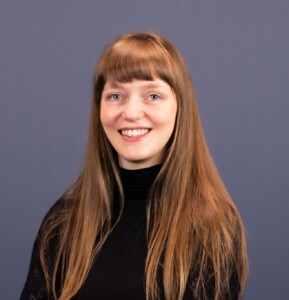

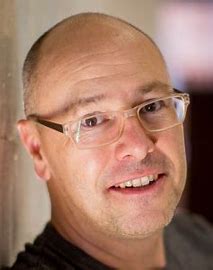
By Melinda Laundon, Postdoctoral Research Fellow, and Jacqueline Greentree, PhD Researcher, Human-Robot Workforce Program, Australian Cobotics Centre
Almost 200 Grade 9 and 10 girls from Gladstone and surrounds gathered at CQUniversity for Try-a-Trade on 15th March. This event brought together manufacturing, aerospace, energy, mining, engineering and construction industry businesses and stakeholders from government and education to encourage female high school students to learn about a range of careers in STEM and try out some practical activities that they might encounter in STEM jobs.
The event was organised by the Gladstone Engineering Alliance in partnership with the National Association of Women in Construction and the Queensland Government‘s Department of Employment, Small Business and Training and Gladstone Manufacturing Hub.
It is important to engage high school students early to consider careers in manufacturing. The lower numbers of women in manufacturing make it particularly important to provide female students with opportunities to consider and experience diverse manufacturing career options. In Queensland, 29% of the current manufacturing workforce are women. While the proportion of women employed in manufacturing has grown dramatically over the past decade, most are in clerical or administrative roles. Only 11% of women in manufacturing are technicians and trade workers[1].
Australian Cobotics Centre industry partner Weld Australia hosted a stall at Try-a-Trade with two Soldamatic welding simulators. This popular activity allows people to experience welding in a safe environment. It also provided a fun competition between girls to compare their welding accuracy. Weld Australia’s Regional Training Coordinator, Adam Coorey said:
“To address the skills shortage, we need to give a greater range of access to the full available workforce. By utilising augmented reality technology, students who would normally shy away from the heat and sparks of a welding bay can try welding in a safe environment. This accessible technology gives students the opportunity to experience a career that they may thrive in”.
At the Cobotics Centre stall, we discussed the impact of cobots and other advanced technology on future work. We also asked students to think about the skills and attributes that would be required in the future to work with a cobot as a team member. They came up with many creative insights, including:
[1] Queensland Department of Regional Development, Manufacturing and Water (2023) Women in Manufacturing Strategy.
Great to see our new PhD researchers, Munia Ahamed and Fikre Hagos out at InfraBuild Sydney with Postdoctoral Research Fellow, Fouad (Fred) Sukkar yesterday.
All of our postdocs and PhD researchers complete a minimum placement of 12 months over their time with us. Generally, this is completed across a number of partners and other organisations to provide our researchers with the industry case studies for their research to apply their research to real world problems, as well as giving them exposure to working in industry.
